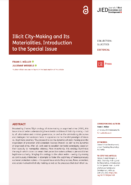Posted on 13 Jun 2018
At least 2.5 million migrants were smuggled in 2016, according to the first Global Study on Smuggling of Migrants released by the United Nations Office on Drugs and Crime (UNODC). Migrant smuggling occurred in all parts of the world, generated an income of up to $7 billion – equivalent to the amount the United States or the European Union spent on humanitarian aid that year – according to the UN agency that fights drugs and crime.
The study describes 30 major smuggling routes worldwide and finds that demand for smuggling services is particularly high among refugees who, for lack of other means, may need to use smugglers to reach a safe destination fleeing their origin countries. Data suggests that many smuggling flows include unaccompanied or separated children, who might be particularly vulnerable to deception and abuse by smugglers and others. In 2016, nearly 34,000 unaccompanied and separated children arrived in Europe (in Greece, Italy, Bulgaria and Spain).
“This transnational crime preys on the most vulnerable of the vulnerable,” said Jean-Luc Lemahieu, UNODC Director of Policy Analysis and Public Affairs and a Global Initiative Network Member. “It’s a global crime that requires global action, including improved regional and international cooperation and national criminal justice responses,” he added.
According to the International Organization for Migration, there are thousands of deaths due to migrant smuggling activities each year. Many smuggled migrants die from drowning, whereas others perish due to accidents or extreme terrain and weather conditions. According to records, the Mediterranean appears to be the deadliest route, with around 50 per cent of the total number of deaths.
Systematic killings of migrants have also been reported along most smuggling routes. But smuggled migrants are also vulnerable to a range of other forms of crime such as violence, rape, theft, kidnapping, extortion and trafficking in persons.
The study also looks at the gender composition of smuggled migrants and finds that this is often influenced by the circumstances driving their mobility, but most of them are relatively young men. On some routes, notably in parts of South-East Asia, however, women comprise large shares of smuggled migrants.
Smuggling may involve complex schemes, such as organizing fake marriages or fictitious employment, counterfeiting travel documents or corrupting senior officials. For this, many smuggling networks engage in systematic corruption at most levels.
The study also explores the links between smugglers and migrants, and finds that as a general pattern, smaller-scale smugglers are either ethnically linked to the territories where they operate, or they share ethnic or linguistic ties with the migrants they smuggle. What is more, some of the migrants who were successfully smuggled become smugglers themselves.
Smugglers advertise their business where migrants can be easily reached, the study says. This includes neighbourhoods that are home to diaspora communities, refugee camps or various social networks online. To make a decision, migrants then rely on the opinion of their communities, relatives and friends, and more recently, of social media.
Moving Forward
When it comes to better strategies for reducing migrant smuggling, the report recommends that a holistic approach must go beyond geographical measures, and include making legal migration opportunities more accessible in origin countries and refugee camps; tackling smuggling networks; and raising awareness in origin communities are just a few ways to combat the scourge.
While data collection, analysis and research on migrant smuggling remain in their infancy, there is a clear need for a solid international body of knowledge to support policy making on migrant smuggling, along with improved data collection systems at the national, regional and international levels, according to the study.



